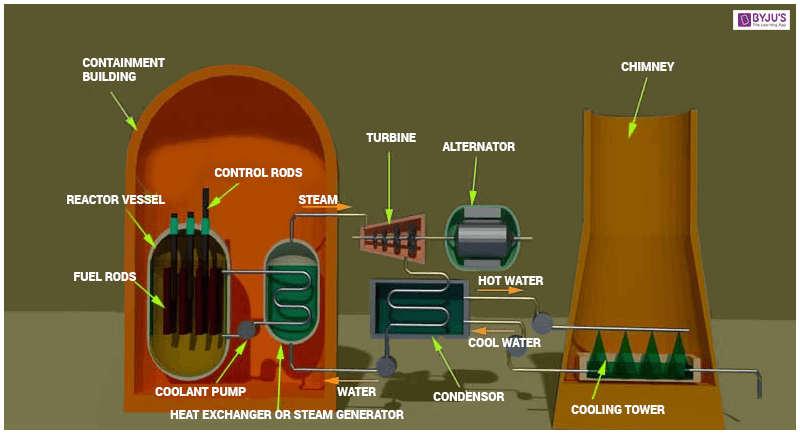Nuclear power is frequently heralded as a cornerstone of modern energy production, serving as a significant alternative to the fossil fuels that currently dominate the global energy landscape. Yet, the question that often surfaces is, how exactly is nuclear power produced? Understanding the multifaceted avenues through which nuclear power is generated can both illuminate the intricacies of this technology and challenge our perceptions of its viability and future. This inquiry delves into the various methodologies through which nuclear energy is harnessed, focusing on the underlying principles, operational processes, and potential challenges associated with each method.
The most prevalent method of nuclear energy production is through nuclear fission, a process that occurs in nuclear reactors. At its core, fission involves the splitting of heavy atomic nuclei, most commonly uranium-235 or plutonium-239, into lighter nuclei. This nuclear reaction releases a significant amount of energy, primarily in the form of heat. This heat is utilized to produce steam, driving turbines that generate electricity. The fission process, however, presents its own set of challenges, particularly related to the sustainability of uranium mining, radioactive waste management, and the potential for catastrophic failures—illustrating a complex challenge that must be navigated in the quest for reliable nuclear power.
In addition to the conventional fission reactors, there exists a burgeoning interest in fast breeder reactors. These advanced systems not only generate power through fission but also create more fissile material than they consume by converting fertile isotopes into fissile ones. Specifically, fast breeder reactors utilize plutonium as fuel and convert uranium-238 into plutonium-239, thereby extending the life cycle of nuclear fuel and enhancing energy security. However, the complexity and cost of constructing and operating these reactors pose significant barriers to widespread adoption. Could the benefits of enhanced fuel sustainability outweigh the formidable challenges that face the implementation of fast breeder reactors?
A relatively new contender in the nuclear energy arena is the concept of nuclear fusion, a process that promises to revolutionize energy production. Unlike fission, which splits atomic nuclei, fusion entails the merging of light atomic nuclei—most notably isotopes of hydrogen, such as deuterium and tritium—to form a heavier nucleus, releasing substantial energy in the process. Fusion is the mechanism that powers the sun, and it holds the tantalizing potential of providing an inexhaustible, clean source of energy without the radioactive waste associated with fission. However, achieving the conditions necessary for controlled nuclear fusion—high temperatures and pressures, coupled with a sustainable reaction rate—remains a monumental scientific challenge. Is humanity on the brink of unlocking the key to harnessing the ultimate energy source, or are we doomed to struggle with these formidable obstacles?
In parallel with these predominant methods, we also encounter thorium-based reactors, a less conventional alternative that leverages thorium-232 as a nuclear fuel. Thorium has significant advantages over uranium: it is more abundant, can potentially be used in a safer fuel cycle, and generates less long-lived radioactive waste. Although thorium reactors are yet to see commercial deployment, their promise could redefine the landscape of nuclear energy. Could the transition to thorium-based reactors provide a solution to some of the ethical and environmental challenges posed by traditional fission methods?
The subject of nuclear energy production also highlights the necessity for advanced monitoring and regulatory frameworks. Given the historically significant accidents associated with nuclear power plants, the implementation of stringent safety protocols is paramount. Automated systems for monitoring radiation levels, along with emergency protocols, serve as critical components in ensuring the safety and security of nuclear operations. Nevertheless, as technology evolves, does the assurance of safety keep pace with the advancements in nuclear reactor design?
Furthermore, the production of nuclear power is not without its socio-political ramifications. The debates surrounding nuclear energy are fraught with public sentiment, often influenced by historical precedents. Proponents argue that nuclear energy can act as a bridge towards a more sustainable energy future, significantly reducing greenhouse gas emissions and reliance on fossil fuels. In contrast, critics highlight the risks associated with nuclear accidents and the unresolved issues surrounding high-level radioactive waste disposal. This dichotomy begs the question: can nuclear energy find a place in a world striving for sustainability without inciting public apprehension?
In summary, the production of nuclear power encompasses various methods, each with its own unique set of benefits and challenges. From the well-established fission reactors to the promising avenues of fusion and thorium technologies, the potential for nuclear energy to contribute significantly to the global energy portfolio is undeniable. However, navigating the intricate challenges of safety, waste management, and public perception remains essential in the ongoing dialogue surrounding nuclear power. Ultimately, as the global community grapples with pressing energy demands and climate change imperatives, the exploration of nuclear energy’s diverse production methods heralds a compelling chapter in the narrative of modern energy production. Will humanity harness this potent force for good, or will the challenges presented stymie its advancement?












